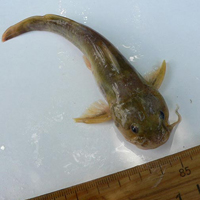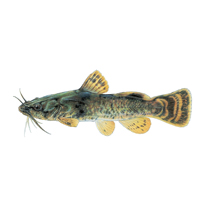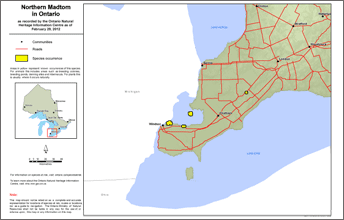Northern madtom
Scientific name: Noturus stigmosus


Cover photos credit: Alan Dextrase (left) and Joseph R. Tomelleri (right)
Status
Endangered
“Endangered” means the species lives in the wild in Ontario but is facing imminent extinction or extirpation.
Date added to the Species at Risk in Ontario List
The Northern madtom was already assessed as endangered when the Endangered Species Act took effect in 2008.
Read the Assessment Report
What it looks like
The Northern madtom is a small catfish that grows up to 13 centimetres in length.
It has four pairs of large whiskers, called barbels, around its mouth that it uses to help find food at night.
This fish is olive-grey to brown in colour, with three dark-coloured blotches on its back, two pale spots in front of the dorsal fin, and three or four dark crescents on the tail fin.
The fins are pale with darker markings. There are sharp spines on the dorsal and pectoral fins and poison glands associated with the pectoral spines.
Where it lives
The Northern madtom usually lives in large creeks and rivers with a moderate to swift current, and a sand, gravel, or mud bottom.
However, in Ontario, this fish has also been captured in the deeper waters of Lake St. Clair and the Detroit River.
It prefers clean, unpolluted water but can tolerate slightly muddy water.
Adults eat aquatic insects, crustaceans, and smaller fish.
During the summer breeding season, Northern madtoms normally build nests under large flat rocks and logs.
Where it’s been found in Ontario
In Canada, the Northern madtom is only found in Ontario in the St. Clair River, Lake St. Clair, the Detroit River, and the Thames River. It has not been seen in the Sydenham River since 1975.
View a Larger version of this map (PDF)
What threatens it
The main threat to the Northern madtom is habitat destruction.
This fish requires clean water in order to survive and can be harmed by pollution and soil that washes into the river from nearby urban and agricultural areas.
Competition from non-native fish is also a potential problem.
Action we are taking
Endangered Species and their general habitat are automatically protected
Recovery strategy
A recovery strategy advises the ministry on ways to ensure healthy numbers of the species return to Ontario.
Read the executive summary (November 22, 2013)
Read the recovery strategy (November 22, 2013)
Government response statement
A government response statement outlines the actions the government intends to take or support to help recover the species.
Read the government response statement (December 15, 2014)
Review of progress
A review of progress made toward protecting and recovering a species is required no later than the time specified in the species’ government response statement, or not later than five years after the government response statement is published if no time is specified.
Read the report on progress towards the protection and recovery of 16 species at risk, including Northern madtom (Noturus stigmosus) (2019).
Habitat protection
General Habitat Protection - June 30, 2013
What you can do
Report a sighting
The Ministry of Natural Resources and Forestry tracks species at risk such as the Northern madtom. Report a sighting of an endangered animal or plant to the Natural Heritage Information Centre. Photographs with specific locations or mapping coordinates are always helpful.
Volunteer
Volunteer with your local nature club or provincial park to participate in surveys or stewardship work focused on species at risk.
Be a good steward
- Private land owners have a very important role to play in species recovery; if you find Northern madtom in a watercourse on or adjacent to your property, you may be eligible for stewardship programs that support the protection and recovery of species at risk and their habitats
- Invasive species seriously threaten many of Ontario’s species at risk; to learn what you can do to help reduce the threat of invasive species, visit:
- Farmers and land owners can help improve fish habitat and keep Ontario’s water safe and clean by maintaining natural vegetation next to creeks and rivers, and keeping pollution and soil from washing into Ontario’s streams and rivers; for more information about programs and funding assistance for eligible land owners visit the Ontario Soil and Crop Improvement Association website
Report illegal activity
Report any illegal activity related to plants and wildlife to
Quick facts
- The sharp spines and poison glands found on the pectoral fins of the Northern madtom can cause a painful wound
- The Northern madtom was only discovered in Ontario in 1963; this fish can be hard to find because it is extremely rare and only active at night
- The male Northern madtom is a protective father; he guards the eggs and the newly hatched young fish and will refuse to abandon the nest even if disturbed
- The Northern madtom is globally rare with fewer than 80 known populations on the planet
